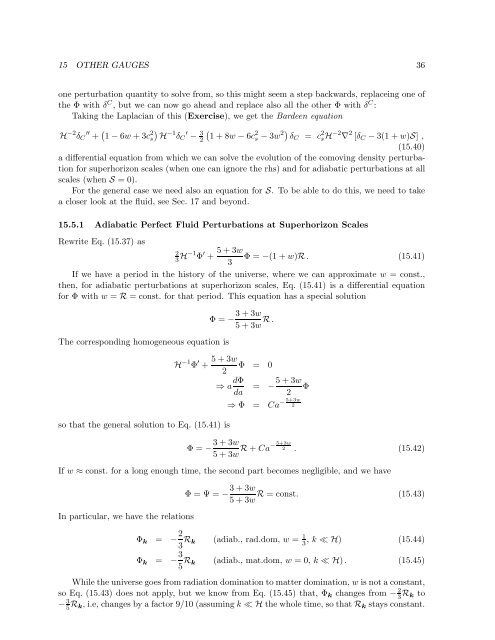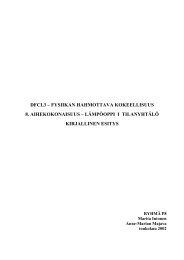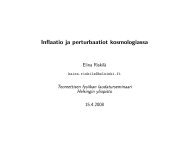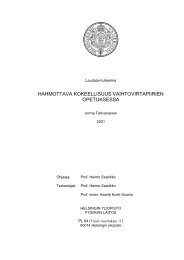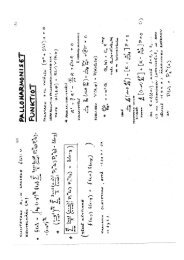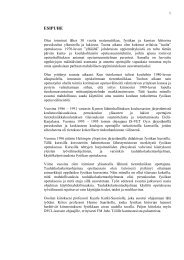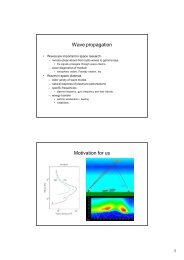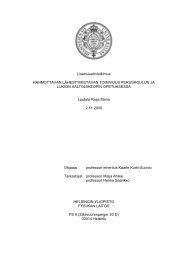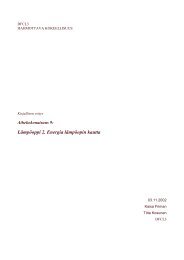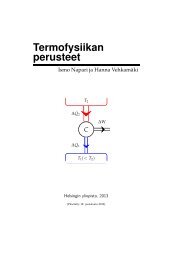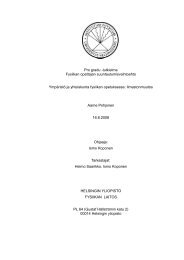Cosmological Perturbation Theory, 26.4.2011 version
Cosmological Perturbation Theory, 26.4.2011 version
Cosmological Perturbation Theory, 26.4.2011 version
Create successful ePaper yourself
Turn your PDF publications into a flip-book with our unique Google optimized e-Paper software.
15 OTHER GAUGES 36one perturbation quantity to solve from, so this might seem a step backwards, replaceing one ofthe Φ with δ C , but we can now go ahead and replace also all the other Φ with δ C :Taking the Laplacian of this (Exercise), we get the Bardeen equationH −2 δ ′′ C + ( 1 − 6w + 3c 2 s)H −1 δ ′ C − 3 (2 1 + 8w − 6c2s − 3w 2) δ C = c 2 sH −2 ∇ 2 [δ C − 3(1 + w)S] ,(15.40)a differential equation from which we can solve the evolution of the comoving density perturbationfor superhorizon scales (when one can ignore the rhs) and for adiabatic perturbations at allscales (when S = 0).For the general case we need also an equation for S. To be able to do this, we need to takea closer look at the fluid, see Sec. 17 and beyond.15.5.1 Adiabatic Perfect Fluid <strong>Perturbation</strong>s at Superhorizon ScalesRewrite Eq. (15.37) as23 H−1 Φ ′ + 5 + 3w Φ = −(1 + w)R. (15.41)3If we have a period in the history of the universe, where we can approximate w = const.,then, for adiabatic perturbations at superhorizon scales, Eq. (15.41) is a differential equationfor Φ with w = R = const. for that period. This equation has a special solutionThe corresponding homogeneous equation isΦ = − 3 + 3w5 + 3w R.H −1 Φ ′ + 5 + 3w Φ = 02so that the general solution to Eq. (15.41) is⇒ a dΦda= − 5 + 3w Φ2⇒ Φ = Ca −5+3w 2Φ = − 3 + 3w5 + 3w R + Ca−5+3w 2 . (15.42)If w ≈ const. for a long enough time, the second part becomes negligible, and we haveIn particular, we have the relationsΦ = Ψ = − 3 + 3w R = const. (15.43)5 + 3wΦ k = − 2 3 R k (adiab., rad.dom, w = 1 3, k ≪ H) (15.44)Φ k = − 3 5 R k (adiab., mat.dom, w = 0, k ≪ H). (15.45)While the universe goes from radiation domination to matter domination, w is not a constant,so Eq. (15.43) does not apply, but we know from Eq. (15.45) that, Φ k changes from − 2 3 R k to− 3 5 R k, i.e, changes by a factor 9/10 (assuming k ≪ H the whole time, so that R k stays constant.


